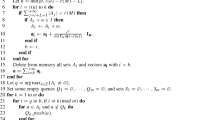Abstract
We consider the max-bisection problem and the disjoint 2-catalog segmentation problem, two well-known NP-hard combinatorial optimization problems. For the first problem, we apply the semidefinite programming (SDP) relaxation and the RPR2 technique of Feige and Langberg (J. Algorithms 60:1–23, 2006) to obtain a performance curve as a function of the ratio of the optimal SDP value over the total weight through finer analysis under the assumption of convexity of the RPR2 function. This ratio is shown to be in the range of [0.5,1]. The performance curve implies better approximation performance when this ratio is away from 0.92, corresponding to the lowest point on this curve with the currently best approximation ratio of 0.7031 due to Feige and Langberg (J. Algorithms 60:1–23, 2006). For the second problem, similar technique results in an approximation ratio of 0.7469, improving the previously best known result 0.7317 due to Wu et al. (J. Ind. Manag. Optim. 8:117–126, 2012).




Similar content being viewed by others
References
Dodis Y, Guruswami V, Khanna S (1999) The 2-catalog segmentation problem. In: Proceedings of SODA, pp 378–380
Feige U, Langberg M (2006) The RPR2 rounding technique for semidefinite programs. J Algorithms 60:1–23
Frieze A, Jerrum M (1997) Improved approximation algorithms for max k-cut and max-bisection. Algorithmica 18:67–81
Guruswami V, Makarychev Y, Raghavendra P, Steurer D, Zhou Y (2011) Finding almost-perfect graph bisections. In: Proceedings of ICS, pp 321–337
Goemans MX, Williamson DP (1995) Improved approximation algorithms for maximum cut and satisfiability problems using semidefinite programming. J ACM 42:1115–1145
Halperin E, Zwick U (2002) A unified framework for obtaining improved approximation algorithms for maximum graph bisection problems. Random Struct Algorithms 20:382–402
Kleinberg J, Papadimitriou C, Raghavan P (1998) Segmentation problems. In: Proceedings of STOC, pp 473–482
Raghavendra P, Tan N (2012) Approximating CSPs with global cardinality constraints using SDP hierarchies. In: Proceedings of SODA, pp 373–387
Saket R (2010) Quasi-random PCP and hardness of 2-catalog segmentation. In: Proceedings of FSTTCS, pp 447–458
Wu C, Xu D, Zhao X (2012) An improved approximation algorithm for the 2-catalog segmentation problem using semidefinite programming relaxation. J Ind Manag Optim 8:117–126
Xu D, Han J (2003) Approximation algorithm for max-bisection problem with the positive semidefinite relaxation. J Comput Math 21:357–366
Xu D, Ye Y, Zhang J (2002) A note on approximating the 2-catalog segmentation problem. Working Paper, Department of Management Sciences, Henry, B Tippie College of Business, The University of Iowa, Iowa City, IA, 52242, USA
Xu D, Ye Y, Zhang J (2003) Approximating the 2-catalog segmentation problem using semidefinite programming relaxations. Optim Methods Softw 18:705–719
Ye Y (2001) A 0.699-approximation algorithm for max-bisection. Math Program 90:101–111
Zwick U (1999) Outward rotations: a tool for rounding solutions of semidefinite programming relaxations, with applications to max cut and other problems. In: Proceedings of STOC, pp 679–687
Acknowledgements
The authors are grateful for the anonymous reviewers to give some helpful comments to improve this paper.
Author information
Authors and Affiliations
Corresponding author
Additional information
The first author is supported by China NSF under the grant 11101261 and Key Disciplines of Shanghai Municipality (S30104). The research of the second author is supported by the Natural Sciences and Engineering Research Council of Canada (NSERC) grant 283103. The third author’s research is supported by NSF of China (No. 11071268), Beijing Natural Science Foundation (No. 1102001), and PHR(IHLB).
Rights and permissions
About this article
Cite this article
Xu, Z., Du, D. & Xu, D. Improved approximation algorithms for the max-bisection and the disjoint 2-catalog segmentation problems. J Comb Optim 27, 315–327 (2014). https://doi.org/10.1007/s10878-012-9526-3
Published:
Issue Date:
DOI: https://doi.org/10.1007/s10878-012-9526-3




